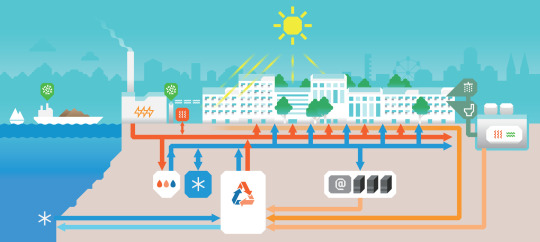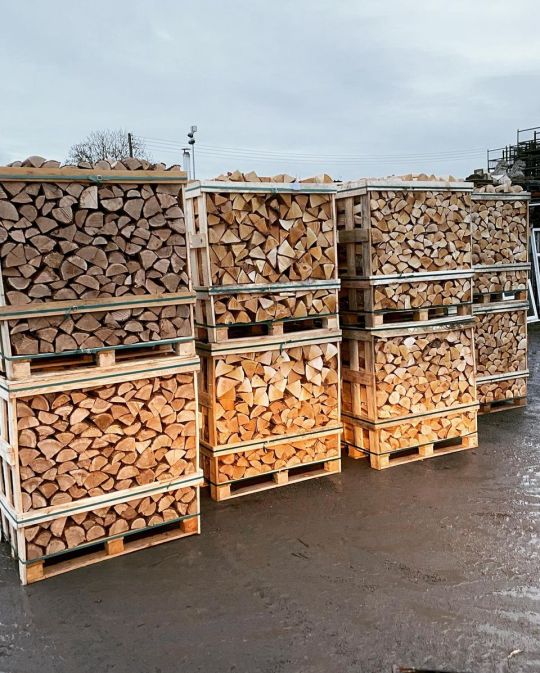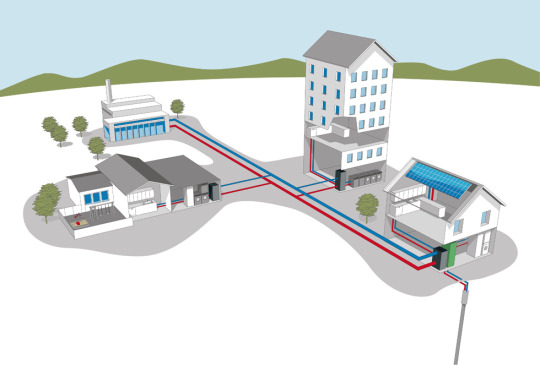#logstore
Explore tagged Tumblr posts
Text
63 notes
·
View notes
Text
District Heating Market Analysis: Global Perspective

The growing district heating market is entering an era of energy transition driven by the increasing focus on renewable and clean energy sources. District heating involves the distribution of steam, hot water or chilled liquids for heating and cooling multiple buildings in a designated area through an underground network of insulated pipelines. It provides an efficient space heating alternative for residential, commercial and industrial buildings. The global district heating market is estimated to be valued at US$ 50.8 billion in 2024 and is expected to exhibit a CAGR of 1.5% over the forecast period 2023 to 2030. Key Takeaways
Key players operating in the district heating market: Key players operating in the district heating market are Vattenfall AB, SP Group, Danfoss Group, Engie, NRG Energy Inc., Statkraft AS, Logstor AS, Shinryo Corporation, Vital Energi Ltd, Göteborg Energi, Alfa Laval AB, Ramboll Group AS, Keppel Corporation Limited, FVB Energy. The major players are focusing on renewable energy sourced heating solutions to gain a competitive edge in the growing market. Growing demand in the market: There is a growing demand for district heating solutions across the commercial, residential and industrial sectors due to their cost effectiveness and energy savings. The increasing focus on reducing carbon emissions is also driving the adoption of low carbon district heating technologies in many countries. Global expansion of the market: Major district heating companies are expanding their global footprint by entering new markets through strategic partnerships and acquisitions. The European countries continue to dominate the market while Asia Pacific region is expected to exhibit fastest growth over the forecast period led by increasing investments in renewable energy based heating projects in China and India. Market Key Trends
The increased focus on renewable energy based district heating is one of the key trends in this market. Renewable sources such as solar, geothermal, biomass are increasingly being used to power district heating plants across regions. This is helping reduce reliance on fossil fuels for heating buildings and lower carbon footprint of the heating sector. Countries like Denmark have adopted renewable sourced district heating at a large scale.
Porter's Analysis
Threat of new entrants: High capital requirements act as a barrier for new companies to enter the district heating market. Bargaining power of buyers: Buyers have low bargaining power due to the essential heating services provided by existing district heating companies. Bargaining power of suppliers: Supplier power is moderate as district heating companies can switch between different fuel sources like natural gas, biomass and waste heat based on prices. Threat of new substitutes: threat is low as there are limited substitutes for district heating networks that provide heating at large scale. Competitive rivalry: Competitive rivalry is high between existing established players owing to their large geographical presence and long term customer contracts. Geographical Regions Europe accounts for the major share of the district heating market in terms of value due to stringent government policies and initiatives in countries like Germany, Poland, Sweden, Denmark and Finland that have enabled large scale development and adoption of district heating networks. Asia Pacific region is expected to be the fastest growing regional market for district heating over the forecast period supported by ongoing expansion of heating infrastructure in countries like China and Japan.
0 notes
Text
Unlocking the Potential of Renewable Energy in District Heating: Market Analysis
District Heating Market will witness highest growth driven by Infrastructural Developments The global district heating market is estimated to be valued at US$ 50.8 Bn in 2024 and expected to exhibit a CAGR of 1.5% over the forecast period 2023 to 2030. District heating refers to the distribution of steam, hot water or chilled water from a central plant for residential and commercial heating requirements such as space heating and water heating. It is considered an efficient method to heat multiple buildings through a system of insulated pipes which transfers heat generated from centralized location through steam or hot water. District heating is advantageous as it provides reliable and sustainable method of heating with greater efficiency while minimizing carbon footprint. Key Takeaways Key players operating in the district heating market are Vattenfall AB, SP Group, Danfoss Group, Engie, NRG Energy Inc., Statkraft AS, Logstor AS, Shinryo Corporation, Vital Energi Ltd, Göteborg Energi, Alfa Laval AB, Ramboll Group AS, Keppel Corporation Limited, and FVB Energy. The global demand for district heating is growing due to rising energy demand from industrial, commercial and residential sectors. Technological advancements such as operation optimization, automation and integration of renewable energy are improving the efficiency of district heating systems. Market Trends The district heating market is witnessing growing focus on renewable energy and low carbon fuels to integrate sustainable heating solutions. Most district heating utilities are investing in renewable technologies such as solar thermal, geothermal, biomass and heat pumps. Secondly, the development of fourth-generation district heating is gaining momentum which utilizes lower temperature heat sources that can be extracted from sewage, ambient heat from rivers and lakes. Market Opportunities Rising investments in infrastructural development of smart cities and urbanization in developing countries provide lucrative opportunities. Advancing technology will play a vital role to develop efficient and low-cost systems. Growing awareness regarding environment protection and policies promoting use of renewable energy will further drive the adoption of district heating solutions. Geographical Concentration of District Heating Market In terms of value, Europe accounts for the largest share of the global district heating market, led by countries like Germany, Poland, Sweden, Denmark and Russia. Europe has a well-established district heating infrastructure serving over 60% of residential heating demand. Central and Eastern European countries are actively investing in network expansion driven by low carbon targets. Asia Pacific is recognized as the fastest growing regional market for district heating globally. Rapid urbanization and industrialization are driving the demand in China, India and Southeast Asian nations. Supportive policies and incentives are encouraging adoption of district heating especially in northern China provinces. Development of new systems integrated with renewable energy and waste heat recovery will accelerate the market growth in Asia Pacific.
0 notes
Text
District Heating Market: Regulatory Framework and Impact Analysis

The global district heating market is estimated to be valued at US$ 50.8 Bn in 2024 and is expected to exhibit a CAGR of 1.5% over the forecast period 2023 to 2030. District heating, also known as teleheating, involves the distribution of steam, hot water or hot air to multiple buildings in a designated area for space or water heating purposes. District heating plants produce steam or hot water at a centralized location and deliver it through a system of insulated pipes in order to supply space heating and hot water to residential and commercial buildings in the area. It is an efficient way of sourcing heat for communities as it reduces infrastructure costs involved in individual heating systems. Rising awareness about carbon footprint reduction and the need for sustainable heating solutions have boosted the adoption of district heating across both developed and developing economies. Key Takeaways Key players operating in the district heating market are Vattenfall AB, SP Group, Danfoss Group, Engie, NRG Energy Inc., Statkraft AS, Logstor AS, Shinryo Corporation, Vital Energi Ltd, Göteborg Energi, Alfa Laval AB, Ramboll Group AS, Keppel Corporation Limited, FVB Energy. Vattenfall AB and SP Group collectively account for over 30% share of the global market. Growing focus on reducing carbon emissions from the building sector has significantly boosted the demand for district heating systems. Stringent regulations pertaining to energy efficiency and use of renewable energy are encouraging utilities as well as commercial and residential complexes to adopt district heating. Technological advancements such as integration of IoT capabilities and advanced sensing equipment in district heating systems allow for improved monitoring and control of the entire network. This has enhanced the operational efficiency and reliability of district heating infrastructure. Use of 4G/5G based communication technologies is also enabling utilities to implement predictive analytics for predictive maintenance. Market Trends Use of renewable and waste heat sources: Growing focus on utilizing renewable and untapped waste heat sources like solar thermal, geothermal, biomass and industrial waste heat for district heating applications presents significant opportunities. Countries like Denmark have successfully demonstrated the potential of renewable district heating. Digitalization of infrastructure: Integration of sensors, IoT, cloud computing, data analytics and automation enables utilities to remotely monitor heat networks and optimize operations. This helps improve efficiency, flexibility and reliability of district heating services. Ongoing development of advanced smart grids supports the use of smart technologies. Market Opportunities Combined heat and power (CHP) plants: Widening scope of cogeneration/CHP technology enables further recovery of waste heat from power generation for district heating. It provides an environment-friendly and cost-effective option for utilities. Renovation of aging infrastructure: As a significant part of the installed district heating systems in Europe and North America is approaching end of life, renovation and modernization of existing pipelines and equipment provides lucrative opportunities. Impact of COVID-19 on the District Heating Market The COVID-19 pandemic has adversely impacted the growth of the district heating market globally. During the outbreak, commercial and industrial activities came to a halt which lowered the demand for district heating from these sectors. This led to a substantial decline in sales revenue for district heating companies in 2020. Many planned projects were deferred or delayed due to supply chain disruptions and halted construction activities during the peak pandemic phase.
0 notes
Photo

Back to school with one small but cute desk, what do you think? . . . . Reposted from @wood.design.kj . #wooddesign #wooddesigns #wooddesigner #logstore #bedroom #bedroomdecor #bed #outdoorfurnite #outdoordesign #handmade #handmadefurniture #woodworking #wood #woodisgood #woodworkers #woodwork #woodlandgarden #woodfurniture #woodfurnituredesign #solidwoodfurniture #storage #storageideas #storagesolutions #nature #style #woodart #wooden #design #designideas #wood #backtoschool https://www.instagram.com/p/B4zvgKXgM0U/?igshid=1q9g331kw4a7d
#wooddesign#wooddesigns#wooddesigner#logstore#bedroom#bedroomdecor#bed#outdoorfurnite#outdoordesign#handmade#handmadefurniture#woodworking#wood#woodisgood#woodworkers#woodwork#woodlandgarden#woodfurniture#woodfurnituredesign#solidwoodfurniture#storage#storageideas#storagesolutions#nature#style#woodart#wooden#design#designideas#backtoschool
8 notes
·
View notes
Photo

Snug as a bug in a... • • #ssh #creature #creatures #nesting #creaturesnesting #shelter #bugs #bugshelter #bug #snugasabug #logs #beesnest #garden #walledgarden #nature #creaturecomforts #brickwall #logstore #bughouse #hibernate #hibernating #spring #springishere #mottisfont #nationaltrust #mottisfontgardens #mottisfontnationaltrust #11promax (at Mottisfont, National Trust) https://www.instagram.com/p/B9WlUdvBLmj/?igshid=s208k807t21i
#ssh#creature#creatures#nesting#creaturesnesting#shelter#bugs#bugshelter#bug#snugasabug#logs#beesnest#garden#walledgarden#nature#creaturecomforts#brickwall#logstore#bughouse#hibernate#hibernating#spring#springishere#mottisfont#nationaltrust#mottisfontgardens#mottisfontnationaltrust#11promax
1 note
·
View note
Photo

Barrow Bags are the perfect shape and size for delivering logs to homes of all shapes, sizes and are easy to move and convenient to store. If you want barrow bags of firewood, visit our logstore at Ludlow Firewood.
0 notes
Photo

Back in the welder this morning and man it felt good. My wrist is healing so I’m back in the saddle! Made the base for a log store this morning but you will have to wait to see the shape but it’s seasonal! Any guesses? #logstore #base #stand #mig #migwelding #handmade #squarebar #steel #workbech #workshop #christmas #etsy #etsyseller #etsyuk #backinthegame (at Hertford, Hertfordshire) https://www.instagram.com/p/Bp4J59yjjVP/?utm_source=ig_tumblr_share&igshid=213m7e79jizo
#logstore#base#stand#mig#migwelding#handmade#squarebar#steel#workbech#workshop#christmas#etsy#etsyseller#etsyuk#backinthegame
1 note
·
View note
Photo




Luckily before the twin storms hit I managed to make up a little indoor log store from 2 recycled wooden plant crates screwed together to fit by our old Rayburn no1 stove .
The 3 recycled cigar boxes on the top hold match's , home made firelighters and various natural tinders and used wax from candles ready to make more firelighters .
#beastfromtheeast#stormemma#recycling#upscaling#logstore#woodstore#rayburn#self sufficiency#preper#staywarm#woodburner#stove#devonlife#cottage#devoncottage#rayburnno1#rayburnstove#fireprep#tinder#fireplace#homeiswherethehearthis#hearth#home#interior decorating#simplelife
50 notes
·
View notes
Photo

It's that time of year again and this bespoke Log store is just about to go to it's new home and of course it's made from 100% recycled timber. #logstore #logs #logfire #reuse #socialenterprise #reclaimed #recyled #wednesdayvibes (at Wiltshire Wood Recycling) https://www.instagram.com/p/CVhyO-OoJrj/?utm_medium=tumblr
0 notes
Photo

🍁We love seeing photos of the different ways people harvest and stack their firewood around the world on @instagram. Like these beautiful photos from @the_seasonal_table in the UK. Speaking of the UK, our only authorized British retail partners @sorbusinternational have just received another shipment of LogOX products in time for the fall harvest. If you live across the pond and want to save on shipping, click the link in their bio to order your LogOX today. 👍🏼🇺🇸🇬🇧🪵 #TeamLogOX #firewood #woodheat #madeinusa #logox #sorbusinternational #regram• @the_seasonal_table As the cooler weather makes itself comfortable, we’re lighting the log burners in the cottage almost every day. This means regular - often torchlit - wellie-booted trips to the logstores to fill up the wood baskets. There is a jumble of seasoned wood in the stores, but ash and beech dominate the pile at the moment. Luckily they are good ones to have; they split well, burn well (for a good length of time), and make a beautiful flame pattern. Definitely worth all the hard work of chopping, splitting, and stacking. - - - - - - #woodpile #logstore #logpile #selfsufficiency #homesteading life #inmygarden #farmlife #rurallife #organic #smallholding #homesteading #homestead #smallholdinguk #smallholder #homesteaders #minifarm #lifeonthefarm #lifeinthecountry #livinginthecountry #ruralliving #thehappynow #heiterautumn (at Somerset, England) https://www.instagram.com/p/CVGdzuVrkrM/?utm_medium=tumblr
#teamlogox#firewood#woodheat#madeinusa#logox#sorbusinternational#regram#woodpile#logstore#logpile#selfsufficiency#homesteading#inmygarden#farmlife#rurallife#organic#smallholding#homestead#smallholdinguk#smallholder#homesteaders#minifarm#lifeonthefarm#lifeinthecountry#livinginthecountry#ruralliving#thehappynow#heiterautumn
0 notes
Text
District Heating Market Trends: Insights and Forecasts

The district heating market provides efficient and environmentally-friendly heating solutions to the commercial and residential sectors. District heating systems utilize steam or hot water that is generated at a centralized location and distributed through a system of insulated pipes for space heating, water heating and process heating requirements. Key advantages of district heating include high efficiency from cogeneration of heat and power, reduction in primary energy consumption and carbon emissions compared to individual heating systems. The global district heating market is estimated to be valued at US$ 50.8 Bn in 2024 and is expected to exhibit a CAGR of 1.5% over the forecast period 2023 to 2030. Key Takeaways Key players operating in the district heating market are Vattenfall AB, SP Group, Danfoss Group, Engie, NRG Energy Inc., Statkraft AS, Logstor AS, Shinryo Corporation, Vital Energi Ltd, Göteborg Energi, Alfa Laval AB, Ramboll Group AS, Keppel Corporation Limited, FVB Energy. District heating demand is growing significantly across European countries due to strict emission norms and rising focus on efficient and clean heating solutions. Major players are expanding their district heating infrastructure and investments globally especially in Asia Pacific region to tap the growing demand for space and process heating from the industrial and commercial sectors. Market key trends One of the key trends in the district heating market is the increasing use of renewable and waste heat sources. With growing emphasis on reducing carbon footprint, district heating system operators are increasingly utilizing renewable energy sources like geothermal, solar, biomass along with waste heat from industries and data centers for cogeneration of heat and power. This is helping reduce the carbon intensity and primary energy consumption of district heating networks significantly. Vattenfall, Engie, Fortum are some leading players investing heavily in modernizing existing networks and designing new district heating systems based on renewable and waste heat resources to meet sustainability goals.
Porter’s Analysis
Threat of new entrants: The district heating market requires high initial investments to set up the infrastructure which acts as a deterrent for new players. However, some local level players can emerge in future. Bargaining power of buyers: The bargaining power of buyers is moderate as switching costs are high for customers who have already invested in district heating systems. However, alternative heating sources provide competition. Bargaging power of suppliers: A few large multinational companies dominate the supply of key equipment and components for district heating infrastructure. This gives them significant influence over prices. Threat of new substitutes: Alternate decentralized heating sources like gas boilers, heat pumps etc. pose a threat. However, district heating is more environment-friendly and gains support through policies in many countries. Competitive rivalry: The market sees healthy competition among the top players. Players compete based on technology, quality, reliability and pricing. Geographical regions with high market concentration
Europe accounts for the largest share of the district heating market, both in terms of value and volume. Countries like Germany, Poland, Sweden, Finland etc have a well-established district heating infrastructure. They have supportive policies and regulations in place to encourage the shift from fossil fuels to renewable sources for district heating. Fastest growing region
The Asia Pacific region is expected to grow at the fastest pace during the forecast period. Rapid urbanization and infrastructure growth is driving the demand. Countries like China, Japan and India are investing heavily in renewable energy-based district heating to meet their carbon reduction goals. Supportive government policies and norms in the region are boosting the adoption of new projects.
0 notes
Photo

The Tao of Logs : made me a log-store from surplus timber last Sunday. Tonight I stacked a half ton of wood in it. #logstore (at Hanworth, Hounslow, United Kingdom) https://www.instagram.com/p/CI07d19hAYL/?igshid=33b349bkt5on
0 notes
Text
District Heating Market Trends: Unraveling the Forces Driving Market Expansion

District heating is a system for distributing heat generated in a centralized location through a system of insulated pipes for residential and commercial heating requirements such as space heating and water heating. It is effectively used for community heating, district heating systems allow the use of a wider variety of energy sources including waste incineration, biomass, geothermal heating, solar thermal energy, and cogeneration. With stringent regulations on carbon emissions, there is a growing demand for cleaner sources of heating such as renewable energy.
The global district heating Market is estimated to be valued at US$ 50.8 billion in 2023 and is expected to exhibit a CAGR of 1.5% over the forecast period 2023-2030, as highlighted in a new report published by Coherent Market Insights. Market Opportunity:
The opportunity to reduce carbon emissions through the use of renewable energy in district heating systems is driving market growth. Renewable sources of energy such as biomass, geothermal and solar thermal can provide clean sources of heating with little to no greenhouse gas emissions. As countries aim to meet climate targets and transition to net-zero economies, there is a growing focus on decarbonizing heating systems. District heating provides an efficient way to integrate renewable energy at scale to replace fossil fuels for residential and commercial heating. The high upfront investment required is being supported through government incentives and policies to encourage the development of renewable energy-based district heating infrastructure. This is expected to provide lucrative opportunities for market players over the forecast period. Porter's Analysis
Threat of new entrants: The district heating market requires high capital investments for infrastructure development lowering the threat of new entrants. Bargaining power of buyers: Buyers have moderate bargaining power due to the availability of alternative heating sources including natural gas, electricity and renewable energy based systems. Bargaining power of suppliers: Suppliers have moderate bargaining power due to the presence of multiple fuel and component suppliers. Threat of new substitutes: Alternatives like individual electric heaters, gas heaters pose low threat due to the economic and environmental benefits of district heating systems. Competitive rivalry: Intense due to the large presence of global players focusing on innovations and expanded operations. SWOT Analysis
Strength: District heating offers lower carbon emissions and energy costs compared to individual options. Renewable energy integration has increased efficiency. Weakness: High initial investments and slow returns hamper small projects. Reliance on limited fuel sources is a risk. Opportunity: Rapid urbanization in developing nations raises demand. Growing focus on reducing carbon footprint favors expansion. Threats: Fluctuating fuel prices increase operating costs. Changing climate policies could impact investments. Key Takeaways
The global District Heating Market is expected to witness high growth. The global District Heating Market is estimated to be valued at US$ 50.8 billion in 2024 and is expected to exhibit a CAGR of 1.5% over the forecast period 2023 to 2030.
Regional analysis related content comprises Regional analysis related content The Asia Pacific region is projected to grow at the fastest pace during the forecast period attributed to rapid infrastructural development and urbanization. China, India and Indonesia dominate the regional industry. Key players related content comprises Key players related content Key players operating in the District Heating Market are Vattenfall AB, SP Group, Danfoss Group, Engie, NRG Energy Inc., Statkraft AS, Logstor AS, Shinryo Corporation, Vital Energi Ltd, Göteborg Energi, Alfa Laval AB, Ramboll Group AS, Keppel Corporation Limited, FVB Energy. Vattenfall AB and SP Group captured over 15% of the global revenue share in 2023.
0 notes
Photo

Did we bypass spring and go straight to summer? What a stunning day here on the farm. I hope you have enjoyed the same. #sun #sunshine #summerishere #summersun #coombemill #logstore #farm #landscape #cornwall #iphonephotography #countryliving #countryside #happyhumpday #outdoorsandhappy #lovelife #whereilive #calm #peaceful #restful
#iphonephotography#sun#outdoorsandhappy#restful#landscape#coombemill#logstore#countryside#whereilive#summerishere#peaceful#farm#summersun#sunshine#happyhumpday#lovelife#countryliving#calm#cornwall
1 note
·
View note
Video
tumblr
Beautifully stacked inside our 1 cubic metre crates, you are effectively purchasing your own logstore as well as the logs. Kiln-dried logs burn very clean, and hence they don’t produce smoke when burned. When you opt for kiln-dried wood, you can rest assured that there is no bad smell.
0 notes